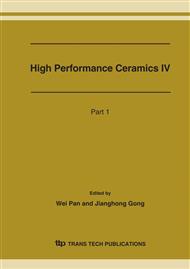p.1531
p.1534
p.1538
p.1542
p.1545
p.1549
p.1553
p.1556
p.1559
In Vitro Degradation of β-TCP/PLLA Scaffolds with Different Proportions of β-TCP
Abstract:
Porous biodegradable scaffolds are widely used in bone tissue engineering to provide temporary templates for cellular attachment and matrix synthesis. Ideally, the degradation rate in vivo may be similar or slightly less than that of tissue formation, allowing for the maintenance of the scaffold structure and the mechanical support during early stages of tissue formation. Eventually, the 3-D spaces occupied by the porous scaffolds will be replaced by newly formed tissue. In this work, β-tricalcium phosphate/Poly-L lactide (β-TCP/PLLA) scaffolds with different proportions of β-TCP to PLLA were investigated. The effects of β-TCP proportions on degradation rate and mechanical strengths of the scaffolds were evaluated in simulated body fluid (SBF) at 37°C up to 42 days. Results show that: different proportions of β-TCP to PLLA have significant influence on degradation behaviors of the scaffolds, and mechanical strengths of the scaffolds with weight proportion of β-TCP to PLLA being 2 to 1 are much higher than those of the others during the degradation period. And in this period, the scaffolds biodegrade slowly, and Hydroxyl Carbonate Apatite (HCA) forms in the surface of the material.
Info:
Periodical:
Pages:
1545-1548
Citation:
Online since:
April 2007
Authors:
Keywords:
Price:
Сopyright:
© 2007 Trans Tech Publications Ltd. All Rights Reserved
Share:
Citation:


